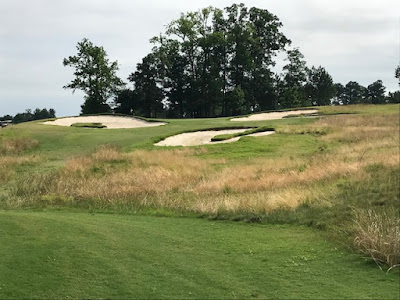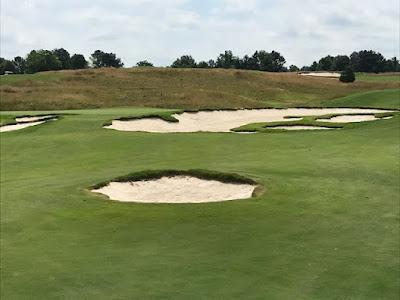One of my four uncles was a PGA Golf Professional. He competed in several "local, regional" tournaments; he may have had a round or two in the Great Greensboro Open in the 1950s. For the most part, he was a club professional, using his skills as an excellent teacher on the practice range and, better yet, while giving playing lessons.
He was always careful and thoughtful to end the session with a positive experience. Maybe just a good swing or a solid ball strike on the range. Possibly a well hit drive on the last hole or a good approach shot or a close-up chip to the green. He knew when to end the lesson. "That's what brings 'em back to the course," he said to me one day. "End the lesson on a positive experience. You want golfers to enjoy the game, to enjoy the lesson, and to have a good feeling once we're done. Don't let them leave with negative thoughts."
Which brings me to Lonnie Poole Golf Course at NC State University and the results of a recent survey: Raleigh skyline makes Lonnie Poole GC's 11th hole the favorite. The 12th and 18th holes tied as the top two least favorite holes, primarily for the drives. The 12th with a relatively narrow fairway requires accuracy off the tee or the second shot may be from the rough on the right or a sand bunker on the left. The 18th, the longest by far of all the par 4 holes from any of the six sets of tees, requires considerable distance if hitting green in two is going to be possible.
The 18th, designated as the No. 4 handicap hole, is without hesitation the toughest hole on the course. The 3rd, 11th and 9th holes, ahead of the 18th in handicap ranking, don't hold a candle to the finishing hole as the toughest hole. Birdies are possible, but so are triple bogeys. Aspiring to make par is a nice goal, but if you get a handicap stroke on the 18th, you should make bogey your goal, celebrate making a par, and figure out what to do next time to avoid double or triple bogey.
The 18th No. 4 handicap designation is systematic because, as is the case with most courses, odd numbered handicap holes are on the front side and even numbered are on the back side. LPGC's 3rd hole is the No. 1 handicap hole but shouldn't be. For most players the par 5 is a three shot hole. The 9th hole is the No. 3 handicap hole primarily for the large green with difficult sloping that turns a good approach into a disappointment. For my money, the 5th hole is tougher than the 9th. The 11th hole, the fan favorite, is the No. 3 handicap hole because of it's length and shallow green, but it's also a three shot hole. Again, for my money, the 12th and 18th holes are tougher than the 11th.
The survey asked players to rate the holes on each nine from most difficult to easiest. Go to that story to see those results. It may be of interest that when the two nines are combined, when the two nines ratings of toughest to easiest are put together, the 18th hole comes out on top as the most difficult, by the long shot. Based on points, this is how all 18 holes would be listed as handicap holes from the No. 1 handicap hole through the No. 18 handicap hole if the two nines are combined:
18th hole — par 4, would be No. 1 handicap hole, currently No. 4
5th hole — par 4, would be No. 2 handicap hole, currently No. 5
3rd hole — par 5, would be No. 3 handicap hole, currently No. 1
12th hole — par 4, would be No. 4 handicap hole, currently No. 8
9th hole — par 4, would be No. 5 handicap hole, currently No. 3
11th hole — par 5, would be No. 6 handicap hole, currently No. 2
13th hole — par 4, would be No. 7 handicap hole, currently No. 10
2nd hole — par 3, would be No. 8 handicap hole, currently No. 9
16th hole — par 4, would be No. 9 handicap hole, currently No. 12
7th hole — par 5, would be No. 10 handicap hole, currently No. 7
15th hole — par 5, would be No. 11 handicap hole, currently No. 6
1st hole — par 5, would be No. 12 handicap hole, currently No. 11
4th hole — par 4, would be No. 13 handicap hole, currently No. 13
10th hole — par 4, would be No. 14 handicap hole, currently No. 16
14th hole — par 3, would be No. 15 handicap hole, currently No. 14
8th hole — par 3, would be No. 16 handicap hole, currently No. 15
6th hole — par 3, would be No. 17 handicap hole, currently No. 17
17th hole — par 3, would be No. 18 handicap hole, currently No. 18
If you take a closer look at all tee boxes on the 18th hole, the most inequitable driving area is the Wolfpack tees at 425 yards. From that tee, the average length of LPGC's eight par fours is 356 yards. There's only one hole over 400 yards, the 18th, at 425. Only two others surpass the average: the 385 yard 5th hole and the 358 yard 9th. The 18th tee is an after thought to the course design. It was added and stuck in a bottom area, probably 10-15 yards in elevation below the next lowest tee boxes, the Gray (379 yards) and Red (441 yards) tees. Despite little hazard to a relatively wide fairway, this may be the toughest tee shot on the entire layout if you expect to make the green in two shots. From the Wolfpack tees, the 18th is nearly 70 yards longer than the average of all par four holes and the biggest differential between the average length of all the par fours and the different sets of tees on the 18th hole.
At Lonnie Poole Golf Course, to have a short game, length off the tees in necessary, and playing up a set of tees is not always the solution. Those who play the Wolfpack tees are rewarded with good drives throughout the course, but when you get to the 18th, a good tee shot might mean a 5-iron or more, usually more, to the green. For some who play the Wolfpack tees and enjoy 17 holes, the 18th is misery, just not approachable in two. To move up to the Gray tees is not a solution for those players. From the Gray tees on the 18th, the drive may require a layup from the second cut that crosses the fairway about 200+ yards off the tee. Laying up a tee shot on the last hole of a round takes the fun out of the game.
It's easy to point out an issue and even easier to make suggestions for change, especially those changes that require substantial investment with no source of funding, but here goes:
- On the 18th, ditch the current Wolfpack tees and extend backwards the Gray tee box about 20 yards, making the hole 399 yards. The 26 yard difference and the tee box elevation would make a huge difference in the hole. Also make the large area of boulders and thorny undergrowth right of the green into a "No Play" penalty area, requiring a one shot penalty and dropping the ball in a drop area about 50 yards from the green, no matter where the ball entered. A "no play" area is exactly what it says: You cannot play the ball from that area.
- Set up the rest of the course as shown on the scorecard with tee markers combined when yardage is the same. Currently, there are 11 sets of tee markers with same yardage that should be combined:
Competition & Black: 4th—373 yds; 15th—549 yds;
Black & Red: 7th—554 yds; 10th—369 yds; 14th— 159 yds; 17th—379 yds;
Red & Wolfpack: 1st—507 yds; 2nd—181 yds; 8th—138 yds; 17th—110 yds;Wolfpack & Gray: 13th—337 yds.
Combining tee markers when the yardage is the same would bring all sets of tees into the correct Course Rating and Slope and it would help with course maintenance.
- Switch the nines: current 1-9 would be 10-18 and current 10-18 would be 1-9. It would allow the 18th hole to become the No. 1 handicap hole. Switching the nines could help with pace of play, especially eliminating the three-group log jam on the current par 3, 2nd hole. And it would give the golf shop staff a better visual of the starting tee,
There's no doubt in my mind the 18th hole at Lonnie Poole Golf Course is the toughest from all sets of tees. Actually it's a really good hole that requires a long and accurate drive and second shots that require avoidance of out of bounds on the left, and the boulder/thorny area and two deep bunkers on the right. The 18th can be a disaster waiting to happen.
Today, when a golf round starts on the 1st hole and ends on the 18th, if you play the last hole very well, at least up to your expectations, your round of golf could be just what my uncle wanted you to have. "End the lesson on a positive experience. You want golfers to enjoy the game, to enjoy the lesson, and to have a good feeling once we're done. Don't let them leave with negative thoughts."
On the other hand, with disaster waiting to happen, walking away with the thought of what could have been a good round, what was upset by that 18th hole is not desirable.
------
Want to comment? Add you thoughts in the comment section below.







































